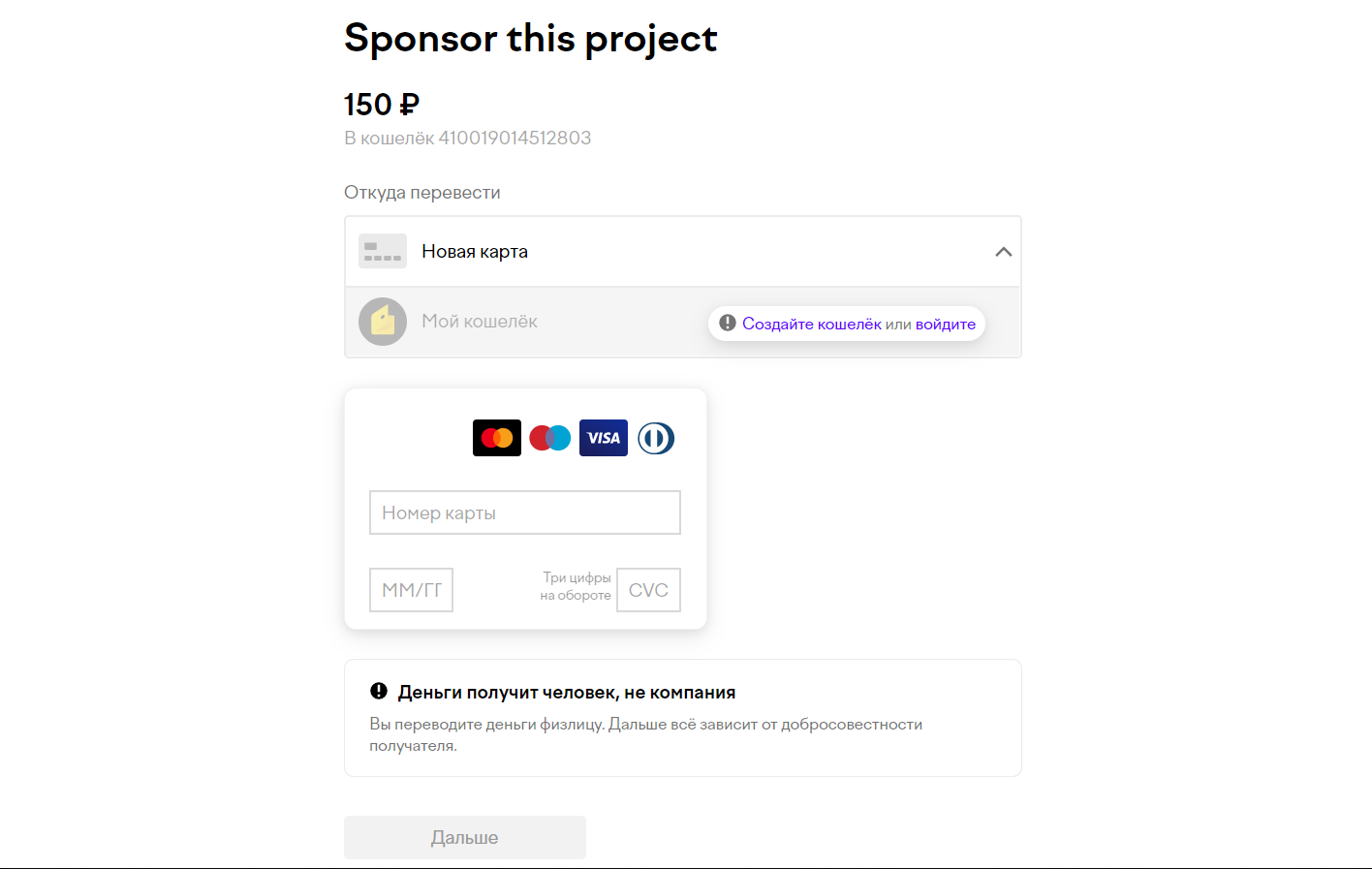In this post, we will learn how to accept payments in the Telegram bot using the Yoomoney API.
Introduction
To begin with, I recently wanted to create an electronic goods store on Telegram. And I ran into the problem that at the time of work there were no ready-made solutions. I wanted to accept payments without individual entrepreneurs and all this movement. Therefore, my choice was between Qiwi and Yoomoney (formerly Yandex Money). I myself am from Belarus ... Therefore, it is easier to get an "Identified" account from Yoomoney.
As a result, I created the yoomoney library for Python.
If this post helped you, please star on GitHub . I will be very pleased!
Description
We get the token
Checking the token
How to issue an invoice for payment
Payment verification
We get the token
In order to use the Yoomoney API, you need to get a special token. First of all, we register the application:
1. Go to the YuMoney wallet. If there is no wallet, create one .
2. Go to the Application Registration page .
3. Specify application parameters:
4. Click the Confirm button .
, , (client_id) , , (client_secret).
!
client_id redirect_uri, .
: . .
pip install yoomoney
from yoomoney import Authorize
Authorize(
client_id="YOUR_CLIENT_ID",
redirect_uri="YOUR_REDIRECT_URI",
scope=["account-info",
"operation-history",
"operation-details",
"incoming-transfers",
"payment-p2p",
"payment-shop",
]
)
! !
YOUR_TOKEN :
from yoomoney import Client
token = "YOUR_TOKEN"
client = Client(token)
user = client.account_info()
print("Account number:", user.account)
print("Account balance:", user.balance)
print("Account currency code in ISO 4217 format:", user.currency)
print("Account status:", user.account_status)
print("Account type:", user.account_type)
print("Extended balance information:")
for pair in vars(user.balance_details):
print("\t-->", pair, ":", vars(user.balance_details).get(pair))
print("Information about linked bank cards:")
cards = user.cards_linked
if len(cards) != 0:
for card in cards:
print(card.pan_fragment, " - ", card.type)
else:
print("No card is linked to the account")
:
Account number: 410019014512803
Account balance: 999999999999.99
Account currency code in ISO 4217 format: 643
Account status: identified
Account type: personal
Extended balance information:
--> total : 999999999999.99
--> available : 999999999999.99
--> deposition_pending : None
--> blocked : None
--> debt : None
--> hold : None
Information about linked bank cards:
No card is linked to the account
! .
Quickpay.
from yoomoney import Quickpay
quickpay = Quickpay(
receiver="410019014512803",
quickpay_form="shop",
targets="Sponsor this project",
paymentType="SB",
sum=150,
)
print(quickpay.base_url)
print(quickpay.redirected_url)
:
https://yoomoney.ru/quickpay/confirm.xml?receiver=410019014512803&quickpay-form=shop&targets=Sponsor%20this%20project&paymentType=SB&sum=150
https://yoomoney.ru/transfer/quickpay?requestId=343532353937313933395f66326561316639656131626539326632616434376662373665613831373636393537613336383639
. . .

, .
: , ?
label - , . , .
:
from yoomoney import Quickpay
quickpay = Quickpay(
receiver="410019014512803",
quickpay_form="shop",
targets="Sponsor this project",
paymentType="SB",
sum=150,
lebel="a1b2c3d4e5"
)
print(quickpay.base_url)
print(quickpay.redirected_url)
.
Client.
Knowing the transaction label , we can filter the wallet's transaction history. Just put a label in client.operation_history ():
from yoomoney import Client
token = "YOUR_TOKEN"
client = Client(token)
history = client.operation_history(label="a1b2c3d4e5")
print("List of operations:")
print("Next page starts with: ", history.next_record)
for operation in history.operations:
print()
print("Operation:",operation.operation_id)
print("\tStatus -->", operation.status)
print("\tDatetime -->", operation.datetime)
print("\tTitle -->", operation.title)
print("\tPattern id -->", operation.pattern_id)
print("\tDirection -->", operation.direction)
print("\tAmount -->", operation.amount)
print("\tLabel -->", operation.label)
print("\tType -->", operation.type)
As a result, we get a list of all operations for our filter:
List of operations:
Next page starts with: None
Operation: 670278348725002105
Status --> success
Datetime --> 2021-10-10 10:10:10
Title --> ****4487
Pattern id --> None
Direction --> in
Amount --> 150.0
Label --> a1b2c3d4e5
Type --> deposition
Now we know if the payment went through.
Everything! Nothing else is needed to receive payments.
Conclusion
If this post helped you, please star on GitHub . I will be very pleased!